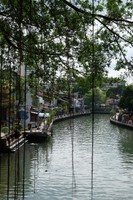Asia
Travel Guide Asia
Introduction

Full Moon Party
© Cyykky
Asia is the world's largest and most populous continent, encompassing China and India, the world's two largest countries population-wise. Well over 4 billion of the world's 7 billion people[1] live in Asia and most of the fastest growing countries and cities can be found here.
From the vast frozen stretches of Siberia to the steamy jungles of Borneo and the dramatic peaks of the Himalayas in the northern part of the Indian sub-continent or the vast deserts of the Arabian Peninsula, Asia is a diverse region that defies categorisation. Modern cities like Tokyo, Shanghai and Singapore herald a growingly urban landscape, but this move towards modernisation is negotiated with the desire to maintain cultural tradition.
Geography
The Asian land mass is huge and with almost 45 million square kilometres it covers around 30% of the world's land area (just under 9% of the total surface of the planet). This section focuses on the area most travellers know as Asia, not the Middle East and Europe, which many geographers consider part of greater Asia or the Eurasian continent. The Asian land mass goes from the frozen dry Arctic in Siberia to the lush and wet jungles of Indonesia and Malaysia. Most of Northern Asia is plains and steppe that gave birth to many amazing empires like the Mongolian Empire. Between North and Central Asia are the Gobi and Taklaman deserts, the latter bordering the Tibetan Highplains. Central Asia is a series of high mountain ranges like the Himalayas, Tianshan and the Hindu Kush with deep depressions that stab way below sea level, making for some very remote cultures and people.
Further south are mountains covered with dense jungles, home to fascinating peoples that live along side wild elephants, tigers and rhinos, although not always in a good way given the extinction of the Java and Bali tiger. Kanha and Bandhavgarh National Parks in India are two of the best parks to see the great Bengal tiger in the world. Asia's geography gives birth to some of the most densely populated places on earth and some places that see a person once every few hundred years. The diversity on this land mass allows any traveller to find what they want.
Subregions
| Central Asia | Afghanistan, Kazakhstan, Kyrgyzstan, Tajikistan, Turkmenistan, Uzbekistan |
| East Asia | China (including Hong Kong, Macau and Tibet), Japan, Mongolia, North Korea, South Korea, Taiwan |
| North Asia | Russia |
| South Asia | Bangladesh, Bhutan, India, Maldives Republic, Nepal, Pakistan, Sri Lanka |
| Southeast Asia | Brunei, Cambodia, Indonesia, Laos, Malaysia, Myanmar, Philippines, Singapore, Thailand, Timor-Leste, Vietnam |
| West Asia (Main article: Middle East) | Bahrain, Iran, Iraq, Israel, Jordan, Kuwait, Lebanon, Oman, Qatar, Saudi Arabia, State of Palestine, Syria, Turkey, United Arab Emirates, Yemen |
Countries and Territories
Note: For countries in West Asia, see main article: Middle East
Sights and Activities
Major cities
Asia is home to some of the largest and fastest growing cities in the world. Many of these cities have upwards of 15 or 20 million people living in or around them. It is expected that in China alone during the next 15 years, about 150 cities will have an additional 2 million inhabitants each! A visit to a massive Mega-Asian city can be a bit overwhelming especially on a first trip. Although seeing that many people living, working and operating in such a close area is truly stunning. Many of the cities have great public transportation systems in them making it easy to get around. Here is a list of some of the major cities in Asia:
- Bangkok, Thailand
- Beijing, China
- Delhi, India
- Hanoi Vietnam
- Ho Chi Minh Vietnam
- Hong Kong, China
- Kolkata, India
- Kuala Lumpur, Malaysia
- Manila, Philippines
- Moscow, Russia
- Mumbai, India
- Seoul, South Korea
- Shanghai, China
- Singapore
- Taipei, Taiwan
- Tokyo, Japan
Landmarks
See also: Famous Landmarks

IMGP8981
© SebKa
How do you create a short list of the most amazing landmarks on the largest continent and one of longest inhabited places on earth? Asian landmarks range from modern buildings to ancient temples, some abandoned and some that have been used for thousands of years. Then on top of the human accomplishments are some of the most stunning natural beauty the world has ever seen. Therefore no matter where you visit in Asia there is some sort of landmark to be experienced. Here is a short list of just a fraction of what Asia has to offer:
- Angkor Wat is a 12th century temple located in the ancient city of Angkor, near Siem Reap in Cambodia.
- Bandhavgarh National Park and Kanha National Park in Madhya Pradesh, India, home to the great Bengal tiger.
- The Darvaza gas crater is one of the most extraordinary sites in Turkmenistan and is one of the most apocalyptic landscapes in the world.
- The Great Wall of China is the longest man-made structure, stretching over 6,500 kilometres across China.
- Lake Baikal is the deepest lake in the world, found in Siberia, Russia.
- Mount Everest in the Himalayas is the tallest mountain in the world, found on the border of Nepal and the Tibetan Autonomous Region in China.
- Mount Kinabalu is the tallest mountain on the island of Borneo and also in Malaysia.
- The Petronas Twin Towers are the tallest twin towers in the world, standing at 451.9 metres in Kuala Lumpur, Malaysia.
- The Taj Mahal is a mausoleum in Agra in central India built by emperor Shah Jahan in memory of his favourite wife, Mumtaz Mahal.
- The Yangtze River is one of the world's longest rivers and flows from the Himalayas to Shanghai.
Getting There
Asia is one of the most popular continents for travellers and as a result, flight connections to other areas are extremely good, especially to India, South East Asia, China and Japan, which all have direct flights from Europe, North America and Australia. There are few, if any, ferry options to get to Asia from North America or Australia, other than hoping for a ride on a cargo boat or yacht. Popular overland routes usually start from Europe, either through Russia by Trans-Siberian Railway towards Mongolia and China (the northern route) or by taking the popular overland route from Istanbul through Turkey and Iran to India (southern route).
Best Time to Visit
Asia is the largest continent on Earth and regional differences regarding the weather are huge. The northern, central and eastern parts of Asia are best visited from late Spring to early Autumn, roughly from May to September. During winter temperatures in Siberia, Central Asia, Mongolia and parts of China can drop below -40 °C. If that's your thing, go for it. But the majority of travellers chooses to visit during the warmer months. July and August can be busy in places, as many locals have their holidays, as well as people from Europe and North America.
On the other hand, the southern and southeastern parts are best visited from November to March, when temperatures are bearable and precipitation is low. This applies to countries like India, Thailand and Vietnam.
Closer to the equator though, in countries like Malaysia and Indonesia, the rainy seasons can be of importance for your choices. Check the country's pages for more details, as they differ within those countries as well.
Learning Asian Languages
These language phrasebooks were created by Travellerspoint members to help travellers pick up some basic phrases, grammar and pronunciation skills before their trip:
- Chinese Phrasebook
- Filipino (Tagalog) Phrasebook
- Japanese Phrasebook
- Lao Phrasebook
- Malay Phrasebook
- Russian Phrasebook
Find out about contributing to or starting a new phrasebook on our project page: Project:Language phrasebooks.
References
- 1 World Population Clock. U.S. Census Bureau. Retrieved on 2009–03–13.
Contributors
 Utrecht (53%)
Utrecht (53%)
from https://utrecht.travellerspoint.com Hien (19%)
Hien (19%)
as well as Lavafalls (9%), dr.pepper (9%), pau_p1 (2%), Herr Bert (2%), arif_kool (2%), Peter (2%), bluetemplediver (1%), hasbeen (1%)
Asia Travel Helpers

claireh
Ask claireh a question about AsiaI spent 8 months travelling all on my ownsome in South East Asia in 2006/2007. I can help (or try at least!) with any questions about Thailand, Cambodia, Vietnam, north Laos, the west coast of Peninsular Malaysia, Singapore, Bali & the Gili Islands.

angusm
Ask angusm a question about AsiaHi there, Im living in Sydney, Australia originally from New Zealand. I have travelled throughout Asia: Thailand, Malaysia, Singapore, Vietnam, Cambodia, Southern China, Hong Kong, South Korea and Japan.
Happy to give advice on travelling in Asia, or Australia or NZ- of course know Australasia inside out!!Happy travelling, Angus

Degolasse
Ask Degolasse a question about AsiaMy interest tends to lie in India, where I spent half a year travelling in 2004. I love to talk about it, so if you got some question, send me a message.
I have also travelled to alot of Southeast Asia (Singapore, Malaysia, Thailand, Cambodia, Vietnam, Laos, and China)on a few different trips. Though I'm sure my info on accomidation and stuff is out of date, I can give lots of advice on the highlights and what to see and do.
vanbest
Ask vanbest a question about AsiaI spend 8 month backpacking in Asia, Nepal - India - Sri lanka - Malaysia - Thailand - Cambodia - Laos - Vietnam - Indonesia - China - South Korea - Japan - Phillipines - Mongolia - Russia Kazakhsthan.
I can advise lets say pretty much about anything usefull you need to know, local transportaion, connection between countries, safety, general questions, etc

baluba
Ask baluba a question about AsiaHaving just returned from a short visit to Indonesia I may be able to help with West Papua (Fak Fak, Kokas), North Sulawesi (Tongkoko) and Maluku (Kei Kecil, Banda, Seram and Ambon).
Just ask and I will see what I can do
This is version 167. Last edited at 8:40 on Mar 25, 24 by Utrecht. 323 articles link to this page.

Except where otherwise noted, content of this article is licensed under a Creative Commons Attribution-ShareAlike 3.0 License



